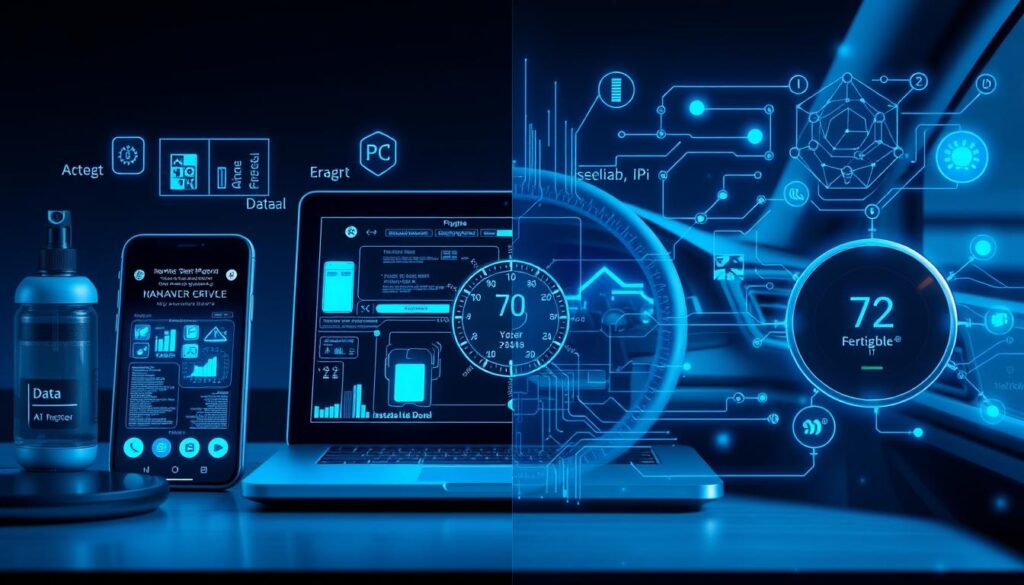Artificial intelligence has quietly woven itself into the fabric of American daily life. That digital assistant helping you navigate traffic, the way your email sorts itself, even how your phone recognizes your face – all powered by AI. According to a recent survey by Pew Research Center, 81% of Americans use at least one AI-powered device or service daily, yet only 38% realize they’re interacting with artificial intelligence. This invisible revolution is transforming how we work, communicate, and live – often without us even noticing.
Smart Assistants: Your AI Companions
Remember when asking your home a question would have seemed absurd? Today, 35% of American households have at least one smart speaker, according to Edison Research. These AI-powered assistants have transformed from novelty gadgets to essential household members.
Alexa, Siri, and Google Assistant use sophisticated natural language processing to understand your requests, learn your preferences, and anticipate your needs. They’re constantly improving through machine learning algorithms that analyze millions of interactions daily.
What They’re Really Doing
When you ask Alexa to add milk to your shopping list, you’re engaging with multiple AI systems simultaneously. First, speech recognition converts your voice to text. Then natural language processing interprets your intent. Finally, the system updates your list while remembering your preferred brand from previous purchases.
These assistants go beyond simple commands. Google Assistant can now make phone calls to book appointments using conversational AI so sophisticated that humans on the other end often don’t realize they’re speaking with an algorithm.
Try This: Unlock Your Assistant’s Hidden Powers
Most Americans use less than 10% of their smart assistant’s capabilities. Ask your device to set routines that automatically adjust your home’s temperature, lights, and security system based on your location or time of day.
Personalized Recommendations: AI Knows What You Want

That eerily accurate Netflix suggestion? The Spotify playlist that seems to read your mind? These aren’t coincidences – they’re sophisticated AI recommendation systems analyzing your behavior patterns.
According to Netflix, their recommendation algorithms save the company approximately $1 billion annually by keeping subscribers engaged with content they’re likely to enjoy. These systems analyze not just what you watch, but how you watch – noting if you binge certain shows, what time of day you prefer certain genres, and even when you pause or rewind.
Beyond Entertainment
Recommendation engines extend far beyond entertainment. Amazon’s product recommendations drive 35% of their revenue, according to McKinsey research. These machine learning models analyze billions of data points to predict what you might need before you even realize you need it.
Even your social media feeds are curated by AI. Facebook’s algorithms analyze over 100,000 personal data points to determine exactly what content will keep you scrolling. These social media platforms use natural language processing to understand post content and machine learning to predict what will engage you specifically.
“The average American interacts with recommendation algorithms 87 times daily, often without realizing these suggestions are AI-generated rather than random,” notes Dr. Alicia Montgomery, AI researcher at Stanford University.
How It Works
Recommendation systems use collaborative filtering (comparing your behavior to similar users) and content-based filtering (analyzing attributes of items you’ve liked) to predict preferences.
Take Control
Most platforms allow you to view your data profile and adjust recommendation settings. Checking these can reveal surprising insights about how AI perceives your preferences.
Smart Home Devices: AI That Learns Your Habits

The modern American home is increasingly intelligent. According to a 2023 report by the Consumer Technology Association, the average U.S. household now contains 22 connected devices, many powered by AI systems that learn from your behavior.
Smart thermostats like Nest don’t just follow programmed schedules – they use machine learning algorithms to analyze your patterns and preferences. After just one week of use, these devices can predict when you’ll be home, when you sleep, and your preferred temperatures for different times of day.
The Invisible Network
What many homeowners don’t realize is that their smart devices are constantly communicating with each other. Your smart doorbell might trigger your lights to turn on, while simultaneously sending a notification to your phone and storing footage in the cloud – all orchestrated by AI systems working in concert.
Robot vacuums like Roomba use sophisticated AI to map your home, identify different floor surfaces, and even recognize pet waste to avoid spreading messes. The latest models can empty themselves, adjust suction based on debris detection, and learn which areas need more frequent cleaning.
Are my smart home devices always listening?
Most voice-activated devices are always listening for their wake word (“Hey Google,” “Alexa,” etc.), but only begin recording and transmitting data after hearing this trigger. However, these devices occasionally activate accidentally, misinterpreting normal conversation as their wake word.
How can I make my smart home more private?
Review privacy settings for each device, regularly delete stored recordings, use mute buttons when privacy is essential, and consider local processing devices that don’t send data to the cloud.
Optimize Your Smart Home
Most Americans aren’t taking full advantage of their smart home’s capabilities. Create automated routines that trigger multiple devices with a single command or event.
Health and Fitness: Your AI Personal Trainer

That fitness tracker on your wrist isn’t just counting steps – it’s running complex AI algorithms to analyze your health patterns. According to a survey by Rock Health, 56% of Americans now use at least one digital health tool, with AI-powered fitness trackers leading the category.
Modern fitness apps use machine learning to create personalized workout plans that adapt based on your performance, recovery, and progress. These systems analyze thousands of data points to optimize your fitness journey, adjusting difficulty and recommending rest days when needed.
Beyond Basic Tracking
The latest generation of health wearables can detect irregular heartbeats, monitor blood oxygen levels, and even predict potential health issues before symptoms appear. Apple Watch’s ECG feature has been credited with saving numerous lives by detecting atrial fibrillation in seemingly healthy users.
Sleep tracking apps employ machine learning algorithms to analyze your sleep patterns, identifying stages of sleep and providing recommendations to improve quality. These applications can detect sleep apnea symptoms and correlate sleep quality with daily activities, helping users understand what behaviors lead to better rest.
AI Nutritional Analysis
Apps like MyFitnessPal now use image recognition to identify foods from photos, automatically calculating nutritional content and making personalized dietary recommendations based on your goals and preferences.
Mental Health AI
Applications like Woebot use natural language processing to provide cognitive behavioral therapy techniques, with studies showing they can significantly reduce symptoms of depression and anxiety.
“The most powerful aspect of AI in health tracking is its ability to identify patterns humans can’t see – correlations between seemingly unrelated factors like sleep quality, heart rate variability, and cognitive performance,” explains Dr. Michael Chen, cardiologist and digital health researcher.
Email and Productivity: AI Working Behind the Scenes

The average American office worker receives 121 emails daily. Without AI, managing this flood would be nearly impossible. Gmail’s spam filters use machine learning algorithms to block 99.9% of unwanted messages, analyzing over 300 billion emails daily to identify new threats.
Smart composition features suggest phrases as you type, learning from your writing style to make increasingly accurate predictions. Google’s Smart Compose helps users write emails 30% faster by suggesting relevant phrases based on context and your personal writing style.
Productivity Enhancement
AI-powered productivity tools extend far beyond email. Applications like Grammarly use natural language processing to check grammar, suggest style improvements, and even adjust tone based on your intended audience. According to Grammarly’s data, their AI helps users be 75% more productive in their writing tasks.
Calendar applications now use machine learning to suggest optimal meeting times based on participants’ availability patterns and preferences. These systems can automatically schedule recurring meetings, suggest agenda items based on previous discussions, and even recommend which participants should be included based on meeting topics.
Document Intelligence
Microsoft’s AI-powered features in Office 365 can automatically generate PowerPoint presentations from Word documents, transcribe meetings in real-time, and suggest data visualizations based on spreadsheet content.
Task Prioritization
Tools like Asana and Monday.com use AI to suggest task priorities based on deadlines, dependencies, and your work patterns, helping users focus on what matters most.
“The most valuable AI tools are those we don’t even notice – they simply remove friction from our daily workflows and let us focus on creative and strategic thinking,” notes productivity expert Laura Vanderkam.
The Invisible AI: Systems You Use Without Realizing

Some of the most powerful AI systems in your daily life are completely invisible. According to a study by the University of California, the average American interacts with 20+ AI systems daily without realizing it. These hidden algorithms shape our experiences in profound ways.
Financial Protection
Every time you swipe your credit card, AI fraud detection systems analyze the transaction in milliseconds, comparing it against your spending patterns and known fraud indicators. These machine learning models have reduced credit card fraud by 70% over the past decade, according to Nilson Report data.
Banking systems use AI to process check deposits via mobile apps, automatically reading handwriting and verifying signatures. These systems have dramatically reduced processing times while improving accuracy rates.
Content Moderation
Social media platforms employ sophisticated AI to filter harmful content before you ever see it. Facebook’s AI systems remove over 3 billion fake accounts quarterly and identify 88.8% of hate speech content before it’s reported, according to their transparency reports.
Streaming services use content moderation algorithms to automatically age-rate shows and movies, identifying potentially sensitive material and helping parents control what their children can access.
Infrastructure Systems
The electricity powering your home is managed by AI systems that predict demand, optimize distribution, and prevent outages. These smart grid technologies have reduced power outages by 20% in areas where they’ve been fully implemented.
Water utilities use machine learning to detect leaks, monitor water quality, and optimize treatment processes. These systems analyze sensor data to identify problems before they affect service or safety.
The AI You Never See
Some of the most sophisticated AI systems work entirely behind the scenes. Weather forecasting uses complex machine learning models to predict conditions with increasing accuracy. Emergency services use AI to optimize response times. Even traffic lights in many cities are now controlled by AI systems that adapt to changing traffic patterns.
What This Means For Your Future

As AI continues to integrate into daily life, Americans face both opportunities and challenges. According to PwC research, AI could contribute up to $15.7 trillion to the global economy by 2030, with much of that value coming from increased productivity and personalization in everyday activities.
The most significant shift will likely be AI’s transition from reactive to proactive assistance. Rather than waiting for commands, future AI systems will anticipate needs based on context, patterns, and preferences. Your morning routine might be automatically adjusted based on your calendar, traffic conditions, and even your sleep quality the night before.
Privacy Considerations
This increased personalization comes with important privacy implications. A recent survey by the Brookings Institution found that 68% of Americans are concerned about AI’s impact on personal privacy, even as they adopt AI-powered services at increasing rates.
The future will likely bring more transparent AI systems with clearer opt-in processes and better controls over personal data. Companies are already developing “edge AI” that processes data locally on devices rather than in the cloud, enhancing privacy while maintaining personalization.
Digital Literacy
Understanding how AI works and affects your life will become an essential skill. Resources like AI literacy courses are becoming increasingly available through platforms like Coursera and Khan Academy.
Personal AI Assistants
The next generation of AI assistants will function more like personal staff, coordinating across devices and services to manage your digital life cohesively.
Prepare for an AI-Enhanced Future
Understanding AI basics can help you make better decisions about which technologies to adopt and how to protect your privacy while benefiting from AI advancements.
Embracing Your AI-Assisted Life

Artificial intelligence has evolved from science fiction to an essential part of American daily life. From the moment your AI-optimized alarm wakes you until your smart thermostat adjusts for bedtime, these technologies are working to make your day more efficient, personalized, and convenient.
The most successful AI applications are often those we barely notice – they simply remove friction from everyday tasks and help us focus on what matters. As these technologies continue to evolve, the line between AI assistance and human activity will increasingly blur.
Whether you’re an early adopter or tech-skeptic, AI is already shaping your daily experiences in countless ways. Understanding these systems helps you make informed choices about which technologies to embrace and how to maintain control over your digital life.
So next time you ask your phone for directions, receive a personalized recommendation, or benefit from a fraud prevention system, take a moment to appreciate the invisible intelligence making it possible. And consider this: what’s one AI system you’ve interacted with today without even realizing it?
Share Your AI Experience
How has AI changed your daily routine? Join the conversation and discover how others are benefiting from artificial intelligence in unexpected ways.








